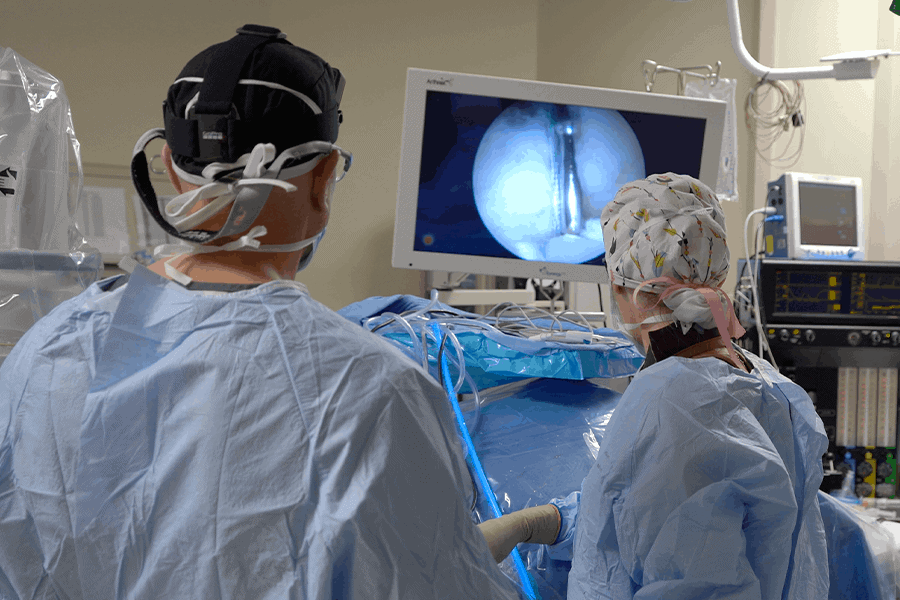What is Outpatient Hip Arthroscopy?
- What happens during outpatient hip arthroscopy?
- How long does it take to recover from hip arthroscopy?
- How does hip arthroscopy help runners?
Outpatient hip arthroscopy is a minimally invasive surgery allowing an orthopaedic surgeon to see and repair the inside of the hip joint without need for a large, invasive incision.
There are a number of advantages to a minimally invasive outpatient hip arthroscopy procedure, including:
- Faster healing
- Less pain
- Smaller scarring
- Reduced trauma to the joint and surrounding tissues
- Lower risk of complications and infections
- Shorter recovery period
- Patients return home the same day as the surgery
Bryan L. Reuss, M.D., a board-certified orthopaedic surgeon and sports medicine specialist, is one of the few providers in the Orlando area performing outpatient hip arthroscopy procedures.
The American Academy of Orthopaedic Surgeons (AAOS) says hip arthroscopy can help relieve some of the pain associated with damage to the labrum, articular cartilage, or other soft tissue in the joint. This damage can come from injury or conditions such as:
- Dysplasia, which occurs when the hip socket is too shallow
- Femoroacetabular impingement (FAI), which causes extra bone spurs to grow in the hip socket or femoral head causing pain during movement
- Joint infection in the hip
- Labrum hip tears
- Loose bodies, which are cartilage or bone fragments that float around the joint
- Snapping hip syndrome causes a tendon to rub across the outside of the joint
- Synovitis, which causes painful joint tissue inflammation
What Happens During Hip Arthroscopy?

Hip arthroscopy is a surgical technique designed to diagnose and treat several kinds of hip issues. During the surgery, which is performed in an outpatient setting (meaning patients go home within a few hours of the procedure), the surgeon will insert a tiny camera, or arthroscope, into the arthroscopic portals, which are small incisions in the hip to perform the surgery. This allows them to see inside the hip and potentially make repairs without a large incision. The procedure has been around for more than four decades and is equal parts safe and successful.
A labrum tear is just one of the conditions that can be treated with this less invasive method of surgery. The labrum is a kind of gasket made of soft tissue that attaches to the bony acetabulum or hip socket. It creates a nice suction so the head of the hip ball joint will fit cleanly into the socket.
Problems can arise when the labrum tear creates the mechanical symptoms of pain, catching, and locking. The arthroscopic procedure cuts away the torn labrum and sutures it back to the bone.
There have been several instances of elite athletes experiencing labrum tears that required hip arthroscopy in the news. All returned to the field of play with great success:
- Washington Capitals hockey play Nicklas Backstrom
- Olympic sprinter Tyson Gay
- Alex Rodriguez of the New York Yankees
One study of athletes and their recovery from hip arthroscopy found, “Female and male elite athletes were able to return to competitive sports activity at the same or higher level after hip arthroscopic surgery.”
Dr. Reuss describes the hip arthroscopy procedure as requiring the surgeon to make small incisions in the leg and insert a cannula and a capsular cutting knife to carefully do the work. The doctor also uses a radiofrequency probe to expose the bone and to cauterize blood vessels that are bleeding.
A 2019 study followed patients who were long-distance runners and underwent this type of hip preservation surgery. Of the 60 patients they followed, ages 14 to 62, 78% returned to some form of running post-surgery, including collegiate and professional activities.
How Can Hip Arthroscopy Help Runners?
 Dr. Reuss recently performed a hip arthroscopy surgery on a 17-year-old female athlete suffering from hip pain.
Dr. Reuss recently performed a hip arthroscopy surgery on a 17-year-old female athlete suffering from hip pain.
In the case of Dr. Reuss’ young patient, she developed severe hip pain while running. After a physical exam, he found a labrum tear in the hip joint (the labrum is the rim of cartilage around the hip socket). Athletes are at higher risk of developing these painful tears.
One of the most common causes of hip pain is overuse, according to Women’s Running, but they point out that hip pain is not normal and should be taken as a sign to go see your doctor for help. Many times, an orthopedic injury can rehabilitate just with rest, physical therapy, and medications. When the pain is too great, hip arthroscopy is a remedy to help these athletes heal and get back to the sport they love.
How Long Does It Take to Recover from Hip Arthroscopy?
Your recovery time depends on the underlying condition the orthopaedic surgeon will be repairing. However, recovery time is always less for the minimally invasive hip arthroscopy procedure. After the surgery, you will experience some pain during the healing and recovery process. You may need a few weeks off from work and you’ll need to curtail certain activities until fully healed. Typically, you can expect:
- Needing some initial help as you become accustomed to crutches
- Restricted ability to drive for a time
- A postoperative appointment 10 to 14 days after the procedure
- Physical therapy
For labrum repair, the typical patient experiencing hip arthroscopy can expect an eight to 12-week healing process with Dr. Reuss and his team at Orlando Orthopaedic Center.


